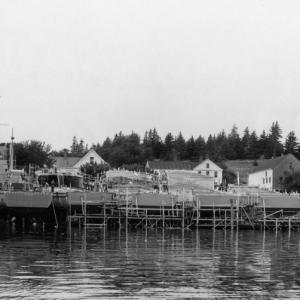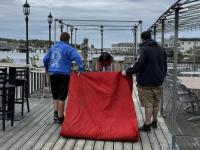Minesweeper Days, 1950s, part IV
 On August 9, 1952, Baxter Rice took this shot of six 144-foot minesweepers under construction in Hodgdon Brothers shipyard. They're strung out north along Lincoln Street, with their bows in the yards of the houses. All the houses were Hodgdon houses originally, with the exception of Nat Wilson's house on the right; it occupies the site of the first 1820s Hodgdon house. Courtesy of Robert Rice
On August 9, 1952, Baxter Rice took this shot of six 144-foot minesweepers under construction in Hodgdon Brothers shipyard. They're strung out north along Lincoln Street, with their bows in the yards of the houses. All the houses were Hodgdon houses originally, with the exception of Nat Wilson's house on the right; it occupies the site of the first 1820s Hodgdon house. Courtesy of Robert Rice
 On August 9, 1952, Baxter Rice took this shot of six 144-foot minesweepers under construction in Hodgdon Brothers shipyard. They're strung out north along Lincoln Street, with their bows in the yards of the houses. All the houses were Hodgdon houses originally, with the exception of Nat Wilson's house on the right; it occupies the site of the first 1820s Hodgdon house. Courtesy of Robert Rice
On August 9, 1952, Baxter Rice took this shot of six 144-foot minesweepers under construction in Hodgdon Brothers shipyard. They're strung out north along Lincoln Street, with their bows in the yards of the houses. All the houses were Hodgdon houses originally, with the exception of Nat Wilson's house on the right; it occupies the site of the first 1820s Hodgdon house. Courtesy of Robert Rice
It was more difficult for shipyards to get Navy contracts in the 1950s than it had been in the 1940s. The Navy had tightened up its procedures and was less forgiving of shipyards' lack of familiarity with the vessels to be built. In the late 1980s, Jim Stevens of Goudy & Stevens described to me the struggle to get contracts for the combined yards of Goudy's and Hodgdon Brothers. Lack of capital and the yards' small size made it problematic. Jim, whose father started the yard with Wallace Goudy in the 1920s, ran the yard with his brother Tunk Stevens and brother-in-law Frank Cummings for many decades after World War II.
Getting the contracts
Jim said, "During World War II, contracts were awarded on a basis whereby yards did half the work on a boat and then negotiated a contract for the finished boat—easier with less guesswork. But we were on a strict contract.We had to guess what the men would work for and estimate what we thought we could get the whole boat out for. That was the way it worked — you were at the mercy of labor once you sign a contract with the number of hours at a given rate.
"We rented the church vestry and got one of those dining tables and spread the blueprints all the way around, studying and estimating there for a month. I think we estimated 350,000 man hours for two boats and gave them a price. As soon as the bids were opened in Boston they called us down and said, 'we like your price and would like you to build four.'
"We said, 'oh, oh, we must have made some mistake if they want more boats.' We had to furnish them with a 100 percent bond furnished by a bonding company. We had a hard stiver (struggle) to get the bonding company to deliver on the basis of our assets. They'd agreed to give us bonds for two, but more? We told the Navy that we didn’t know if we could get the bonds in Boston.”
Bonding by road trips
"But I, my brother Tunk, our brother-in-law Frank Cummings, and Sonny Hodgdon and Clyde Jones (of Hodgdon Brothers) went to Aetna in Boston to see if we could get bonded for four; they sent us on to Washington where we went to the Aetna bonding and casualty office,” Jim said. “They said, 'We can’t help you here but we will call the president of the company.' He called back and said he would see us the next morning at 10:30 a.m. So Sonny, Frank and I left Washington at midnight, drove to Hartford, and got there around 8 a.m. We had time to change and spruce up and head for the Aetna office.
"You should have seen this darn office that they ushered us into; it was set up like Hitler getting ready to entertain Mussolini. He was up on this big dais at the end of the hall, it seemed like we had to march for an hour and a half to get down to him. But he listened to us and said, 'Under ordinary conditions I’d just say no, but I am going to call the Boston office and have Mr. Crandall meet you in Boothbay tomorrow morning and go over the yard.'
"So Sonny, Frank and I piled into the car, and we were supposed to pick up Tunk and Clyde in Boston. They'd stayed in Washington for further negotiations with the Navy and meant to fly into Boston where we were to pick them up. We waited for two or three flights but they didn’t show. So Sonny, Frank and I drove back to Boothbay and we got here just about daylight — just in time again to shower and clean up to meet Crandall.
“He looked the place all over, called some fellow, and said, 'They don’t fill the normal criteria, but I recommend that you give it to them.' So they were very kind and gave us the bond for four boats, and we wound up with two more contracts, building 12 boats in four years.”
Honing those skills
"Our man hours were shy on the first boat,” Jim said. “When we got through that contract, we had been awarded the second four boats, and our hours kept improving as the men got better trained by repeating what they had been doing. By the time we got to the fifth boat they had shaved $100,000 off those boats. Then it just about leveled off. If we had built one boat at our price we would have lost our shirts, but by the repetition the men got skilled at what they were doing.
"That is why contracting is one of the biggest gambles in the world. You don’t know how much labor will produce for you; it depends on skill and attitude and everything. I know time and again I estimated jobs based on what we had done before and some other man would come along and take twice what you put in his time for. It was the biggest gamble in the world."
Jim Stevens, a founding and lifelong trustee of the historical society, died in 2002.
Event Date
Address
United States























